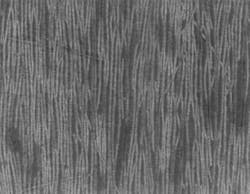In a palm-fronted office building less than two miles from Venice Beach, a small Los Angeles startup is trying to work around the limits of silicon and in radio applications. As smartphones start talking over higher frequency bands, it has proposed reaching them with chips made out of carbon.
The company, Carbonics, recently revealed a line of chips based on carbon nanotubes—thin sheets of carbon atoms rolled into straws. When layered on silicon wafers, the straws act like electrical highways, providing many vital qualities for tapping into the latest wireless networks.
The Zebra wafers, which the company released last month, are named after their precisely aligned rows of carbon nanotubes. That design makes them vastly more linear and efficient at high frequencies than silicon and other common materials, said Kos Galatsis, a founder and chief executive at Carbonics, in an interview.
Founded in 2014, Carbonics is betting that carbon-on-silicon chips will take off with 5G wireless networks, which will extend the instantaneous sharing made possible by smartphones to cars and sensors. But industry executives widely expect 5G to break into millimeter wave frequency bands, which are extremely tricky for standard CMOS chips to amplify and switch.
“The device performance has not kept up with the enthusiasm [for high frequency communications],” Galatsis said.
Many wireless parts are based on gallium-arsenide (GaAs) to amplify, filter, and manipulate signals in high-frequency bands. But at the same time, chip designers are increasingly trying to cast power amplifiers, mixers, and other parts in silicon, so that multiple functions can be compressed on a single chip.
Carbonics claims that its chips bridge the gap between the materials, allowing engineers to make single chips compatible with CMOS circuits that simultaneously support technologies ranging from 2G and 4G to Wi-Fi and WiGig.
“What we are looking at is something like gallium arsenide on silicon technology,” Galatsis said, adding that the carbon-on-silicon chips could also cut down on power consumption in smartphones and wireless sensors that have to run for years on batteries.
A university spinoff, Carbonics is building on technology that had been in development at the University of California, Los Angeles, for around 10 years. Galatsis said that he recently started working full-time at the seven-person company. He had previously worked as a professor of Material Science and Engineering at UCLA.
Though innovation has been slow, carbon nanotubes are making waves in other applications as well. IBM researchers are layering them onto silicon to make extremely tiny computer chips, while other are using them as memory and sensor devices. But Galatsis sees an immediate opening for the wireless industry.
“The market has gone gangbusters,” he said. In recent years, wireless chip suppliers have started selling parts for more than just wireless infrastructure, smartphones, and defense electronics. Increasingly, manufacturers are buying parts for automotive radar, home appliances, and radiation-hardened electronics for small satellites.
Carbonics has raised $5.5 million in funding from Taqnia International and has also received funding from the Defense Advanced Research Projects Agency (DARPA) and the Semiconductor Research Corporation. In 2015, it signed a contract with the U.S. Air Force to develop carbon nanotube transistors for amplifying radio signals.
The company plans to launch its Viper product line for commercial wireless equipment and aerospace applications later this year. After that, it plans to release another generation of chips, called Stingray, which will include integrated circuits for low-noise amplifiers, switches, and front end modules for millimeter-wave applications in 2018.
But there are still potential struggles ahead. In recent years, scientists have found success in pushing silicon to higher frequencies without carbon nanotubes. Others have built CMOS circuits out of gallium nitride, though Galatsis says that carbon nanotubes handle low voltages much better than GaN.
There is a cautionary tale in the fall of RF Nano, one of the few compaines to have also tried selling carbon nanotube chips for RF applications. Founded in 2006, it raised around $9.5 million in funding for its CMOS-compatible chips, but it has since closed down, according to the Wall Street Journal.
For now, Galatsis is taking a conservative approach to selling the carbon-on-silicon chips, aiming the Zebra wafers at scientists and researchers. But he views the release as crucial first step: “We have to start crawling before we start walking and running.”
Correction: February 15th, 2017 . An earlier version of this article misstated the title of Kos Galatsis, a founder and the chief executive of Carbonics, a Los Angeles startup making advanced radio chips from carbon nanotubes. He is a former professor of Materials Science and Engineering, not one of Electrical Engineering. The article also incorrectly cited one of the startup's investors. It is Taqnia International, not Saudi Arabia's Taqnia Investments.


